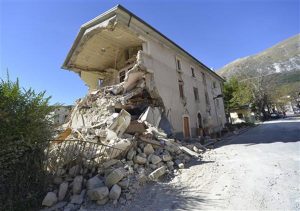
A wave of earthquakes has rocked central Italy in recent months, shattering medieval towns and destroying ancient homes, churches and landmarks. The latest—a magnitude 6.6—over the weekend struck a cluster of historic mountain towns, the most powerful temblor to hit Italy in more than three decades. The new shaking comes as the region reeled from a deadly magnitude 6.2 quake in August that killed 300 people and a pair of strong quakes last week.
How are the quakes related? Do they foreshadow an even bigger temblor? Scientists are studying the relationship of the quakes, which occurred on several faults in the Apennines mountain range.
A look at earthquake terminology:
Q: How are earthquakes defined?
A: An earthquake is generally characterized as a foreshock, main shock or aftershock.
The largest quake in a series is the main shock. Foreshocks are quakes that strike before the main shock along the same fault. Aftershocks are smaller quakes that rattle the same general area following the main event. Aftershocks generally become less powerful and less frequent over time.
Not all quakes have foreshocks, but moderate and strong quakes are followed by a series of aftershocks.
Scientists don’t know beforehand what type of quake it’ll be until the shaking has played out.
Q: What about the Italy quakes?
A: The Italy quakes are under investigation, but it appears the previous quakes including the deadly August temblor were foreshocks to Sunday’s quake, said U.S. Geological Survey seismologist Paul Earle.
While the latest quake was the largest in the sequence, no deaths were reported because thousands of people had evacuated to shelters and hotels after the earlier quakes.
Earle said the chances of an even larger quake striking the same area are low.
Q: Can a main shock become a foreshock?
A: Days before the 2011 Fukushima nuclear disaster in Japan, several strong quakes including a magnitude 7.3 rattled the region. That quake had been considered the main shock until a magnitude 9 struck off the coast of Japan, generating a tsunami that swamped the Fukushima Daiichi nuclear power plant.
Q: How long can aftershocks last?
A: Aftershocks can last for days, weeks or even years depending on the strength of the main quake.
Recent disasters—such as Fukushima and the 2004 magnitude 9.1 quake in Indonesia that triggered an Indian Ocean tsunami that killed 230,000 people in a dozen countries—have been followed by tens of thousands of aftershocks.
Note: The above post is reprinted from materials provided by The Associated Press.










